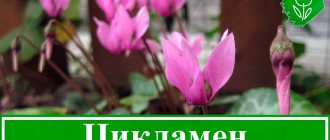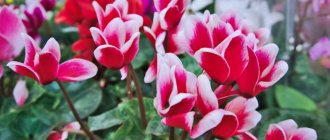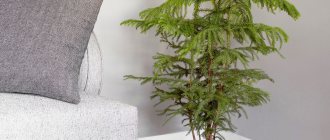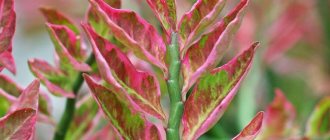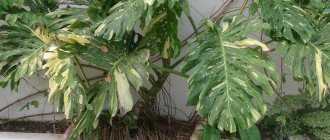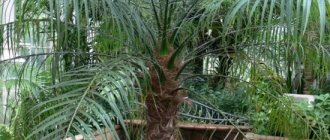Among indoor vines there are many original and even exotic plants. But hardly anyone is able to compete in their “peculiarity” with dyschidia. This is a unique, very graceful epiphytic plant, in which, in addition to charming small main leaves, water-storing “bubbles” are also formed. Delicate shades of green and the brightest scarlet or pink color of miniature flowers, flexibility of shoots and elegance make dischidia a real legend. And although it is not easy to grow, how much joy and pleasure it brings afterwards!
Dischidia ruscifolia. © WoS
Content
- General information
- Dischidia species and varieties
- Dyschidia care at home
- Watering dischidia
- Soil for dyschidia
- Fertilizer for dyschidia
- Dischidia bloom
- Pruning dyschidia
- Dyschidia transplant
- Caring for dyschidia during the dormant period
- Dischidia growing from seeds
- Propagation of dyschidia by cuttings
- Diseases and pests
- Conclusion
General information
This compact vine has an extraordinary decorative effect, which it maintains throughout the year. Its peculiarity is that it has several types of leaf plates framing curly, flexible shoots. Some leaves are elliptical with a pointed end, while others are large, juicy and bubble-like. They store water in case of drought. This unusual structure of the leaves is due to the fact that the exotic grows in the tropics, where there is often drought, and in order to protect itself from death, the plant thus stores water.
In addition to the unique leaf plates that give the dischidia exoticism and originality, its second decoration is small inflorescences of a red or pink hue, which appear in early spring and remain in the axils of the leaves until the end of summer, resembling a scattering of precious stones on a green background.
In the wild, the plant grows in the tropics. It can be found in Polynesia, Australia and India. Dischidia is an epiphyte that is attached to the bark of trees using an aerial root system. The crop belongs to the Kutrov family and has about forty varieties, only seven of which are grown at home.
Nummularia
Nummularia (Pangolin kisses) will not leave anyone indifferent. Most often it is grown in hanging containers, where it looks very attractive due to its thick climbing shoots up to 1.5 meters long, densely strewn with light green, round, plump leaves up to 1 cm in diameter.
The leaves are similar to coins, which is why the second name of the variety is coin. Due to its unusual exotic appearance, other translations of the name of the plant are known - dragon's kiss, lizard's kiss.
In almost every leaf node along the entire length of the shoot axillary inflorescences are formed, blooming with small white flowers.
Nummularia differs from its relatives in its slow growth, so if you want to see the beauty of the variety faster, it is better to purchase adult specimens.
It is worth noting that this variety is not cheap, and after purchasing it you will have to arrange “dances” near the bush in order to please the capricious vine by strictly observing the conditions of maintenance.
In the photo below is the variety Dischidia Nummularia:
Dischidia Nummularia
Dischidia species and varieties
Dischidia Comb - is a vine with creeping, flexible branches with an aerial root system on them. The plant has two types of leaf blades: the main ones are light green and additional ones that look like large bubbles. The bubble-shaped leaves are green on top and brick-colored underneath. The inflorescences of the culture are small, red or pink.
Dischidia Ovata - the plant has long, pinkish-green stems. The main leaf blades are oval with a pointed end. They have a green tint with white streaks on the surface. The crop blooms from early spring to late summer. The inflorescences are small, five-petaled in white, pink or red.
Dischidia Rusifolia - the plant has an elegant shape, long and flexible stems framed by bright green leaf plates in the shape of hearts. The inflorescences are small, white in color with a slight aroma of honey.
Dischidia Appel - the culture has long, elastic branches on which there are a large number of large, fleshy leaf plates, shaped like an apple. They have a light green tint and white spots on the surface. The inflorescences are small, white or pink.
Dischidia Raffles - the plant has stems reaching a length of up to 5 meters. They are framed by oblong, dense leaf plates of a light green hue. The inflorescences of the culture are umbrella-shaped, small, five-petaled, yellowish in color.
Dischidia Apple Leaf - the stems of the crop are flexible, long and elastic. The leaf blades are large, fleshy, green with white specks. They are shaped like apples. The inflorescences are white, small with a light, pleasant aroma.
Dischidia Khirsuta is a rare variety of crop that has long branches with rounded foliage with dense pubescence. The leaf blades have raised venation. The flowering time of the plant occurs at the beginning of spring and lasts until the end of summer. The inflorescences are small, purple, located on short peduncles.
Dischidia Million Hearts - the plant has long, flexible shoots, with short internodes, densely framed by small variegated leaf plates with pointed ends. The inflorescences are five-petaled, small, pink or red.
Ovoid
Ovate (Ovata) is a hanging plant that is unpretentious in cultivation and can withstand drafts. Flower growers note that when an ovoid dischidia is placed in the coldest place under a window, the active period of budding begins and Ovata will soon bloom.
When open, the flowers in different shades of pink and orange reach a diameter of 2.5 cm. This variety is characterized by a greenish-pink color of elongated long stems with neat oval-shaped leaves, on which white veins are clearly visible. The leaf blades are velvety and slightly wavy to the touch.
You can see what the Dischidia Ovate variety looks like in the photo below:
Dischidia Ovate Ovata
Dyschidia care at home
Dischidia is an exotic plant in every way. Although it is considered easy to grow, this is far from true. If the crop is not properly cared for, it will shed its leaves and begin to wither. Therefore, before purchasing it, the grower must carefully study the information about the plant in order to understand whether he can provide it with the necessary conditions for growth and development or not.
Dischidia belongs to the category of light-loving plants. If in the wild it grows in the darkness provided by tall trees in tropical forests, then at home it needs to be grown in a well-lit place. However, it should be taken into account that the light should be diffused and not direct, otherwise burns may appear on the crop. The plant can also be grown in a florarium under artificial light. You can place the culture in the bathroom if there are windows facing west or east. This room will be an ideal place for the plant.
Dischidia is a heat-loving plant. The optimal temperature for its growth and development is from 18 to 30 degrees. In the winter, they need to be reduced to 18 degrees, and in the summer they should be maintained between 22 and 30 degrees. It is at this temperature that the crop blooms best.
The most difficult thing when caring for a plant is to maintain the air humidity it needs, since it must be very high. It is for this reason that experienced gardeners recommend growing it in a florarium. But you can also ensure a humid environment by daily spraying and installing a humidifier in the room. You also need to ensure that the humidity does not fall below 50%. But the most optimal indicator is still considered 90%.
Hoya is an evergreen tropical vine. It can be grown with care at home without much hassle if you follow the rules of agricultural technology. You can find all the necessary recommendations in this article.
Air humidity
The most stringent requirements are imposed on the characteristics of the air - its high humidity, and therefore the best conditions are created in terrariums for plants. But growing it as an ampelous plant or a vine with a support is quite achievable.
It is important to provide comfortably humid conditions - dischidia can be sprayed. It is resistant to getting wet. Pallets with wet pebbles or moss are perfectly acceptable. You can also install special humidifiers. Stable humidity levels of 40-50% will be optimal.
Watering dischidia
The plant loves moisture very much, but does not tolerate overwatering, so it should be watered so that the substrate is constantly moist. To do this, watering should be carried out only after the top layer of soil has dried. The crop needs to be watered three times a month. In winter, watering is reduced to once a month. If dischidia is grown on tree bark, then it is moistened twice a week.
The water used for irrigation must be settled or filtered or boiled. In addition, it must be at room temperature so as not to harm the plant.
Grebeshkovaya
When grown on a support, it is possible to create a living green wall due to the large number of aerial roots, which looks very picturesque in the interior of the room. The climbing epiphytic plant has original comb-like foliage and amazing blooms of purple pitcher flowers. When watering a flower you need to be restrained. The substrate should be moist, but not swampy. When there is a lack of light, dischidia sheds its leaves, so in winter you need to take care of artificially illuminating the bushes.
Dischidia Grebeshkovaya
Soil for dyschidia
The plant should be grown in orchid soil that is fairly loose and fibrous. If a gardener wants to prepare it himself, then he needs to mix leaf soil, peat and sphagnum in a ratio of 2:3:1.
If the crop will be grown in a florarium, then the soil mixture must be prepared from fine pine bark or crushed fern roots mixed with sphagnum in a 2:1 ratio. You can also add a little charcoal to the substrate, which will serve as a kind of fertilizer for dischidia.
Fertilizer for dyschidia
Although the plant needs to be fertilized, this should be done very modestly. Most often, gardeners feed the plant only twice a year with fertilizer for foliage crops or succulents, diluted in half the dose. They fertilize in April and July.
In addition, you can fertilize the plant once a month during spring and summer, using a reduced dose of fertilizer. It is better to alternate them, adding a nutrient composition at the root and spraying the foliage with it.
Dischidia bloom
The plant blooms from early spring to late summer. Some varieties of the crop also bloom in winter. The inflorescences are small, collected in umbrellas. They can have a bright pink, red and white hue, depending on the varietal of the dischidia.
In addition, some varieties emit a pleasant sweetish honey aroma during flowering.
Ruskusolistnaya
The length of the shoots varies from 50 cm to one and a half meters. A characteristic feature is the similarity of the variegated fleshy leaves with hearts, for which the plant is lovingly called a million hearts. Flowering lasts all year round with white or pink-white flowers from which a honey aroma emanates. Requires high humidity and heat for rapid growth. Young specimens feel better in a greenhouse or under a hood.
Dischidea is ready to put up with the dry air for a while, but the roots cannot tolerate the bay after it dries out and begin to rot.
The photo below shows Dischidia Ruscusifolia:
Dischidia Ruscusolifolia
Dyschidia transplant
The crop can be replanted only in the spring and only if signs of active growth appear. Only young crops should be replanted annually, but only if the roots have begun to fill the planting container and come out. Each time you replant, you should take a pot that is slightly larger in volume and diameter. It is preferable that the container is made of plastic and must have drainage holes. In addition to pots, dischidia can be grown on blocks or driftwood.
When transplanting, you need to form a high drainage layer in advance, which will prevent the accumulation of liquid at the roots. Also, during the procedure, you should handle the root system of the plant very carefully, otherwise if it is damaged, the epiphyte may simply die.
Landing
The soil in which the plant is planted must be well-permeable to moisture and air. The best option is a special composition intended for crops of this type. The soil should include:
- charcoal;
- sphagnum;
- pine bark;
- leaf soil;
- river sand;
- perlite
It is important not to forget about the drainage layer. This is necessary to ensure that moisture does not stagnate. The container for planting can be any.
The young flower is transplanted in the spring. The procedure begins only when signs of strong growth are detected. The root system should completely fill the pot.
Caring for dyschidia during the dormant period
The plant's dormant period begins at the beginning of winter and lasts until spring. At this time, the temperature in the room should be reduced to 18 degrees, watering should be reduced to once a week, and it is advisable to remove spraying altogether or carry it out once every three days.
Fertilizing should also not be applied in winter. With the onset of spring, active skincare procedures need to be resumed.
Khirsuta
in the collections of flower growers . The leaves are round in shape with dense pubescence, pointed at the ends, and a relief pattern is clearly visible on the surface. Produces buds of a wonderful wine color. More often they are grown in hanging containers, from which stems up to one and a half meters long hang down. Throughout the year, you should not drop the temperature below 18 degrees Celsius.
Dischidia Hirsut
Dischidia growing from seeds
To propagate a plant by seed, you need to wait until, after flowering, pod-like fruits are formed, which have flying seeds that look like dandelions. You need to work with them carefully, as they are very small and easily lost.
Seeds should be sown in spring. For sowing, you need to use a soil mixture that includes sand and peat or sand and leaf turf in equal proportions. Seeds should not be distributed densely over the soil. It should be watered before the procedure. After sowing the seeds, you should sprinkle them with a small layer of peat on top, cover them with film and put them in a warm and well-lit place.
Every day the film must be removed and the seedlings ventilated. When the first shoots appear, the container with them should be shaded so that they are not exposed to direct sunlight. When a pair of leaf blades appears on young plants, they need to be picked to a permanent place of growth.
General information:
Diascia The
Diascia flower reaches a diameter of no more than twenty millimeters; its appearance is similar to the snapdragon flower. The perianth is tubular, has five lobes, the upper two have spurs, the three below are large, the so-called lower lip is formed. The multiple flowers are pink, orange, salmon, purple and remain on the stem for a long time.
The genus Diascia has more than fifty species, some of them are annual plants that grow in lowland parts of the natural environment, others, representatives of the mountainous region, are perennials. The latter species is common in Europe as an ornamental plant.
Ease of propagation, rapid development and abundant long flowering have made Diascia a popular annual. The numerous drooping stems dotted with flowers are especially impressive when grown in pots and containers. It blooms in waves, the first flowering lasts a month from the beginning of summer, then after pruning, the bush blooms again until mid-autumn.
Propagation of dyschidia by cuttings
To propagate the crop using cuttings, you need to use the tops of young branches. To do this, you need to cut them diagonally and immediately sprinkle the cuts with charcoal. The length of planting material should be no more than 10 centimeters. It needs to be rooted in a mixture of peat and sand, planting the cuttings at a slight slope.
Planting containers with cuttings should be covered with a cut-off plastic bottle and placed in a warm, well-lit place. Every day the cap must be removed and the seedlings ventilated, as well as maintaining optimal soil moisture. The cuttings will take root in three weeks.
Another way to propagate a crop using cuttings is to take ready-made planting material from the leaves of the blisters. In the adventitious leaf blades, in most cases, daughter plants develop, which are located inside the leaf under favorable conditions.
To get them, you need to carefully cut the leaf, remove the cutting from there and plant it in a planting container in a permanent place of growth without any preliminary preparation.
A million hearts
Overall, Million Hearts performs well due to its heart-shaped leaves and delicate white bell-shaped flowers. Doesn't like being moved to another place during flowering. The flowers immediately dry out and only a few remain on the stem. It differs from ruscusolifolia in the color of the foliage; this variety has a bright green color. At the slightest deviation from the conditions of maintenance, the trunk dries out, the foliage begins to wrinkle and fade. Spraying with soft water and alternating fertilizer for orchids in low concentration stimulates growth and flowering.
Dischidia Million Hearts
Diseases and pests
Among the diseases, the plant is susceptible to root rot, which develops when the soil becomes waterlogged as a result of improper watering. Root rot leads to the withering of the crop and its death. You can save a diseased plant by replanting it in a fresh substrate and a new pot with preliminary pruning of the affected roots and treating them with a solution of potassium permanganate.
Dyschidia can also be attacked by pests such as mealybugs and spider mites. To destroy them, the plant must be treated with the Actellik insecticide according to the instructions on the package with the drug.
Common problems
Problems arise from improper care. If the air is dry, spider mites and aphids may appear. When the soil is waterlogged, the root system and shoots will begin to rot.
If the air humidity is very low, then the bubble bags will be without water, and this leads to an imbalance. Also, low humidity will cause the leaves to deform and the tendrils will become dark. When red dots are found on the leaves, this means sunburn.
Such a plant is the dischidia liana. It is difficult to grow, but those who already keep it are simply fascinated by this beautiful, unusual and such a spectacular flower.
In another article we described: Croton: propagation and care at home
